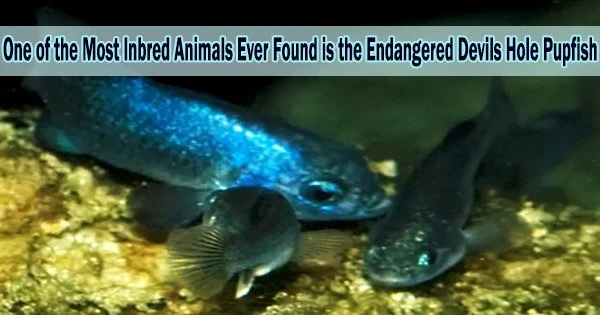The Devil’s Hole Pupfish inhabits a very horrific environment, as its name suggests. 263 of them are confined to a single deep limestone cave in the Mojave Desert of Nevada, where the water temperature is perpetually around 93 degrees Fahrenheit, food is so scarce that they are constantly on the verge of starvation, and oxygen levels are so low that most other fish would die right away. Of all known vertebrates, the pupfish Cyprinodon diabolis inhabits the tiniest habitat.
The significant impact that these severe and isolated settings have had on this fish’s genetic diversity is now supported by new studies.
In a paper published this week in the journal Proceedings of the Royal Society B, University of California, Berkeley, biologists report the first complete genome sequences of eight pupfish species from the American Southwest 30 individuals in all, including eight Devils Hole pupfish. Surprisingly, the Devils Hole pupfish has undergone such intense inbreeding that, on average, 58% of the genomes of these eight individuals are identical.
“High levels of inbreeding are associated with a higher risk of extinction, and the inbreeding in the Devils Hole pupfish is equal to or more severe than levels reported so far in other isolated natural populations, such as the Isle Royale wolves in Michigan, mountain gorillas in Africa and Indian tigers,” said lead researcher Christopher Martin, UC Berkeley associate professor of integrative biology and curator of ichthyology in the campus’s Museum of Vertebrate Zoology. “Although we were not able to directly measure fitness, the increased inbreeding in these pupfish likely results in a substantial reduction in fitness.”
The researchers discovered that other pupfish species are likewise inbred, but only 10% to 30% of their genomes are identical.
The Devils Hole pupfish exhibit an amount of inbreeding comparable to what would occur if four to five generations of siblings interbred, according to graduate student David Tian, the study’s lead author. As a result, dangerous mutations are more likely to be fixed or burned in rather than eliminated, potentially driving a population to extinction through a mutational meltdown.
High levels of inbreeding are associated with a higher risk of extinction, and the inbreeding in the Devils Hole pupfish is equal to or more severe than levels reported so far in other isolated natural populations, such as the Isle Royale wolves in Michigan, mountain gorillas in Africa and Indian tigers.
Christopher Martin
Although populations of Devils Hole pupfish in the wild and in captivity, or “refuge” populations, are currently thriving, the species’ low genetic diversity could cause problems if climate change and human influences increase.
The new genome sequences will aid researchers and conservationists in evaluating the health of native pupfish populations and maybe intervening in refuge populations to boost the genetic variety of these species, specifically the Devils Hole pupfish.
“With this new genomic data, there’s a lot of potential to look not just at genetic diversity and how these species are related to each other phylogenetically, but also look at inbreeding and mutation load to get an idea of what their current status is, how evolutionary history may have influenced their current genetic variation, and think about where the population is going and what we should do, if anything, to preserve these species,” Tian said.
Population decline and rescue
Pupfish species are dispersed over the world and frequently choose remote lakes and springs with harsh conditions that most fish would not be able to survive. Warm, saline desert springs and streams in California and Nevada are home to about 30 different species.
Martin has researched a number of pupfish populations, including a few in the Bahamas’ San Salvador Island, to better understand the genetics underlying their capacity to survive in harsh environments and specialized ecological niches.
Martin said that the Devils Hole pupfish is special due to its restricted range and precarious existence, which makes environmentalists concerned about its varying wild population.
“Part of the question about these declines is whether they may be due to the genetic health of the population,” Martin said. “Maybe the declines are because there are harmful mutations that have become fixed because the population is so small.”
Martin pointed out that human intrusions into their habitat had contributed to the reduced number. In the 1960s and 1970s, local ranchers and developers tapped groundwater in the area, substantially lowering the water level in Devils Hole and causing a population decline.
Devils Hole and its inhabitants were preserved by a 1976 Supreme Court decision allowing the federal government to prohibit groundwater extraction, and the endangered species was protected by captive breeding at a nearby 100,000-gallon pool at the Ash Meadows National Wildlife Refuge.
Nevertheless, a decline in the 1990s led the wild population to its nadir in 2013: 35 individuals. The Since then, the wild population has increased while the refuge population has grown to 400, which is double the wild number.
However, not all of the genetic variety in the Devils Hole pupfish can be attributed to humans. The genome of a pupfish that was captured in 1980 and kept at the University of Michigan was also sequenced by the UC Berkeley researchers.
It displayed inbreeding and a lack of genetic variety similar to those observed in newly captured individuals, the majority of whom passed away naturally. This suggests that over hundreds or even thousands of years, the pupfish population has probably experienced frequent bottlenecks.
Martin and Tian discovered that 15 genes have completely vanished from the Devils Hole pupfish genome as a result of this. Five of them appear to play a role in adjusting to life in hypoxic or low-oxygen settings.
“These deletions are a paradox, because this is a habitat where you’re most exposed to hypoxia,” Martin said. “It could have something to do with the stability of the habitat over time. But it looks to us like the hypoxia pathway is broken. Once you break one gene, it doesn’t really matter if you break additional genes in that regulatory pathway. Our future work is to actually look at what these deletions do. Do they increase tolerance of hypoxia? Do they decrease tolerance of hypoxia? I think those two scenarios are equally plausible at this time.”
He suggested that selective breeding could assist promote diversity and possibly prevent the extinction of the Devils Hole pupfish species. Additionally, CRISPR genome editing could re-add missing genes to the body.
The fact that the genome of the fish collected in 1980 was about as inbred as today’s fish is “maybe good news,” Martin said, “in that the population has historically been highly inbred with very low genetic diversity, suggesting that the recent decline in the ’90s, with population bottlenecks to only 35 fish in 2013 and 38 fish in 2007, doesn’t seem to have had much of an effect.”
Tian is currently examining 150 full genome sequences from nine species of American pupfish in order to have a better understanding of the harmful mutations and gene deletions that have occurred in the distinct populations of the Southwest. He views the findings as a demonstration of what conservation genomics may accomplish for globally threatened and possibly inbred populations.
“We’re on a really cool cusp when it comes to using genomic data and applying it to conservation, especially at a time where it’s a problem that is likely only going to get worse with climate change and increased habitat fragmentation and just anthropogenic changes,” he said.
However, Tian is wary of genetic treatments because it is unclear how genes affect a species’ physical and behavioral traits and how this relates to fitness and adaption to a particular environment. Conservation should still be a priority.
“The answer is still increased funding for these populations, protecting habitats, legal avenues for protecting these species and figuring out ways for humans and these endangered species to coexist on this planet,” he said.
Co-authors with Martin and Tian are Austin Patton of UC Berkeley and Bruce Turner of Virginia Tech in Blacksburg. The U.S. Fish and Wildlife Service, National Park Service, National Science Foundation (1749764) and National Institutes of Health (5R01DE027052-02) fund the work.
















